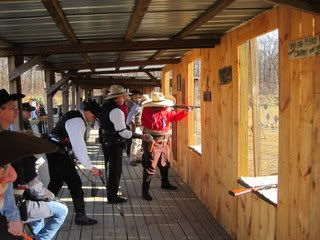

 The Accurate Reloading Forums
The Accurate Reloading Forums  THE ACCURATE RELOADING.COM FORUMS
THE ACCURATE RELOADING.COM FORUMS  Guns, Politics, Gunsmithing & Reloading
Guns, Politics, Gunsmithing & Reloading  Gunsmithing
Gunsmithing  Alcohol based dyes for gun stock?
Alcohol based dyes for gun stock?Go  | New  | Find  | Notify  | Tools  | Reply  |  |
| one of us |
I used to use Fiebings leather dyes to stain wood arrows back in the 90's. I just acquired a H&R Topper 410 shotgun, that I am thinking about refinishing. After all the usual prep, I'm thinking of staining it with Fiebings leather dye. Has anyone done this? I like alcohol, because it drys quick. Wondered if it would streak? Any thoughts appreciated. Mad Dog | ||
|
| one of us |
I tried this on a piece of walnut that I was using as a forend tip. Read about it in an old gunsmithing book. Several coats and then a light coat of satin polyurethene finish and it didn't look half bad. Not near as nice as ebony or rosewood, but was acceptable for this project. | |||
|
one of us |
My suggestion would be to 'pretreat' the wood with Cabot conditioner. This will open the wood pores and keep you from a blotchy finish. | |||
|
| One of Us |
Hey..I'm not trying to be the resident worrier here...most alcohol dyes are analine based...bad stuff! check out the label to be sure, and./or wear protective gloves | |||
|
| One of Us |
Duane Wiebe ; Why do you consider Aniline dye to be bad ?. There are 3 types Water which is bad for gunstocks IMO . Alcohol which is soluble in thinners including alcohol and there is Oil Aniline dyes either of these two have worked very well for me over the years . As I'm not a Gun Smith and only do refinishing and restoration wood working and have for 40 years . I'm curious as to why you consider it bad ?. If applied correctly as with most anything it can give marvelous tone quality's unachievable with any other type stain , while allowing grain detail to Shine !. The biggest difference between stains and dyes is the color -- many stains look muddy, sort of like looking through a window with the screen on. Remove the screen and you get an idea of the clear colors produced by aniline dyes. The reason is simple. Most stains leave tiny colored particles (pigments) on the surface of the wood. But dyes penetrate the wood fibers. This emphasizes the figure of the wood instead of partially obscuring it. Aniline dyes also color the wood more evenly than pigmented stains. Unlike stains that concentrate in the areas of the wood that have large pores (like end grain), dyes penetrate all parts equally. Another nice thing about aniline dyes is the wide range of colors. There are even bright primary colors, like what you might want to use on kids' projects. Regardless of the color, most dyes are sold as a dry powder that needs to be dissolved in a solvent, either water, alcohol, or oil. Of the three, the guys at | |||
|
| One of Us |
I thought the H&R Topper was a birch stock, IF so I've played hell in the past trying to get white/birch to turn out nice looking...Never could get stain to get inside the wood or a good even NATURAL look to it. _____________________ Steve Traxson | |||
|
| One of Us |
| |||
|
| One of Us |
So it's simply the handling of the materials which concerns you , not actually the finishes it produces . Thanks for the clarification . PS Please don't put the worry into an old fellow like that I figured I'd been doing it all wrong for 40 plus . | |||
|
| One of Us |
fiebings works great. they are supposed to be the ones who make chestnut ridge's stain. I use thinned linseed oil first on a new stock, flood it, let it soak, then remove as much as you can with a towel, let dry a day. that prevents the end grain from getting too dark. birch is tough to dye though, the dye can look orange if you don't dye it down dark. | |||
|
| one of us |
Well, the fiebings worked great! I used the straight mahogeny, and it has given it a nice reddish brouwn hue. I started putting the poly on, and am up to the 4th coat. I shoot it, let dry for 2 hrs., then lightly hit it with 0000 steel wool, wipe it off with a tac cloth, then hang and shoot it again. Think I'll put 7-8 coats on it, then let it cure for 1-2 days, then put the little gun back together. I'm pretty happy for my 1st time doing this. Mad Dog | |||
|
| Powered by Social Strata |
| Please Wait. Your request is being processed... |
|
 The Accurate Reloading Forums
The Accurate Reloading Forums  THE ACCURATE RELOADING.COM FORUMS
THE ACCURATE RELOADING.COM FORUMS  Guns, Politics, Gunsmithing & Reloading
Guns, Politics, Gunsmithing & Reloading  Gunsmithing
Gunsmithing  Alcohol based dyes for gun stock?
Alcohol based dyes for gun stock?

Visit our on-line store for AR Memorabilia

